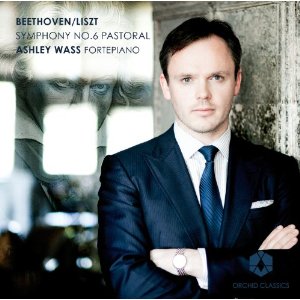A kind of homespun ambient charm characterizes Ashley Wass’ recording of the Beethoven “Pastoral” Symphony in Franz Liszt’s solo-piano transcription. He recorded it on an unidentified fortepiano in the Great Chamber at Restoration House, a historic pre-Civil-War town house in Rochester, Kent. The instrument emits an annoying, buzzing percussive sound when played loud and holds its tuning precariously, yet softer passages reveal an attractively diverse range of colors and timbres. I even like the strange residual overtones from certain hammer strokes. The room’s slightly bouncing echo also exaggerates the fortepiano’s mechanical noises (pedal shifts, hammer strikes, and so forth) and what sounds like people walking around from time to time.
Having previously recorded Beethoven/Liszt (the Ninth Symphony for two pianos, on modern concert grands), Wass unsurprisingly demonstrates a solid technique and command of Liszt’s daunting keyboard textures. While Wass favors measured tempos for the most part, his steady rhythm, sense of contrapuntal clarity (the Storm movement’s building layers), and long-lined breadth (the controlled build-up in the first-movement development and the Finale’s introduction) prevent things from dragging.
To be sure, Yury Martynov’s fortepiano “Pastoral” (available from Zig-Zag Territoires, and coupled with the Second Symphony) benefits from a far more stable Erard instrument and superior sonics. And while there’s much to respect regarding Wass’ sober musicianship, I prefer Martynov’s overall fleeter tempos, kinetic energy, and virtuosic elan, although his modifications and inflections of pulse can be fussy and capricious to the point of predictability. Considering how rarely the Beethoven/Liszt symphonies turned up on disc in the 1970s, collectors today certainly are spoiled for choice.
































